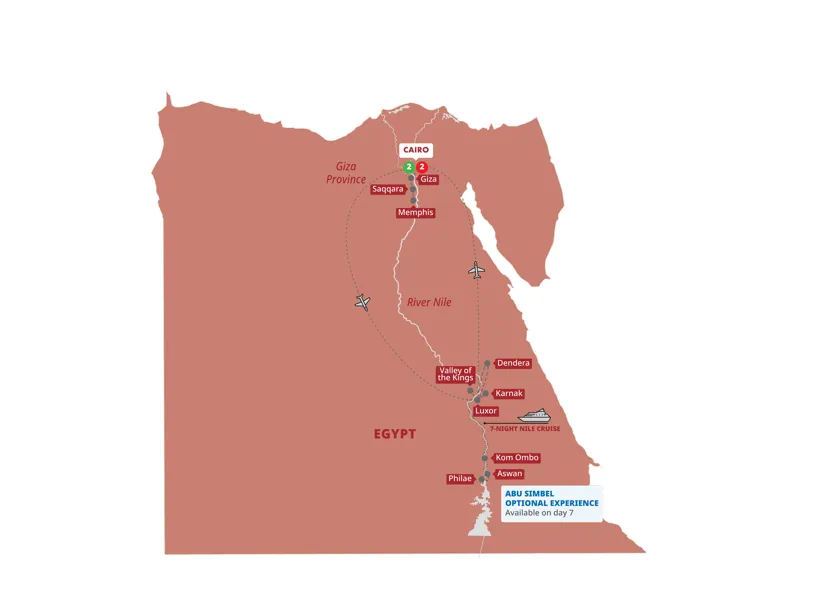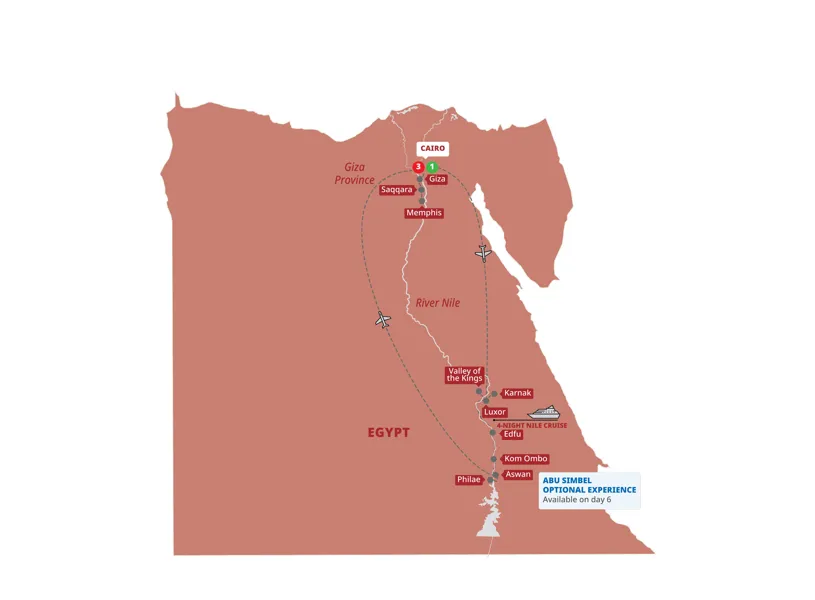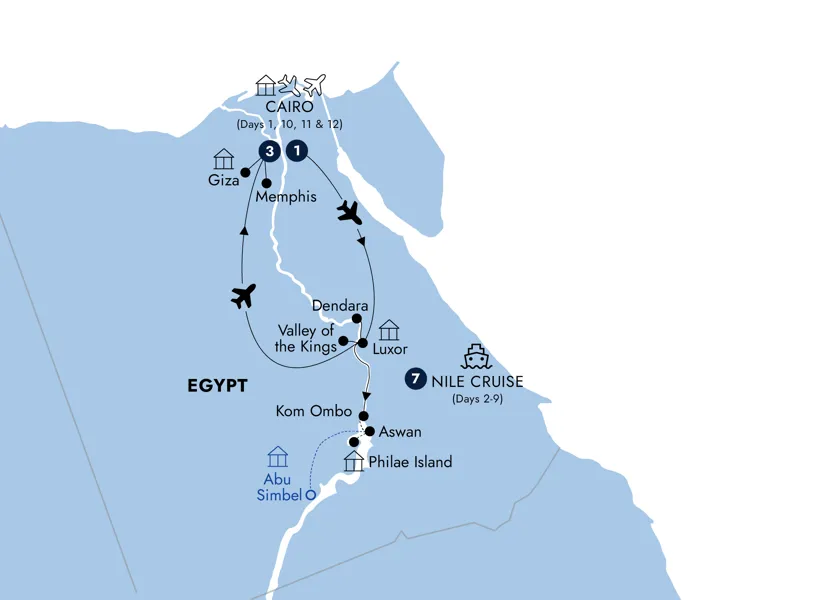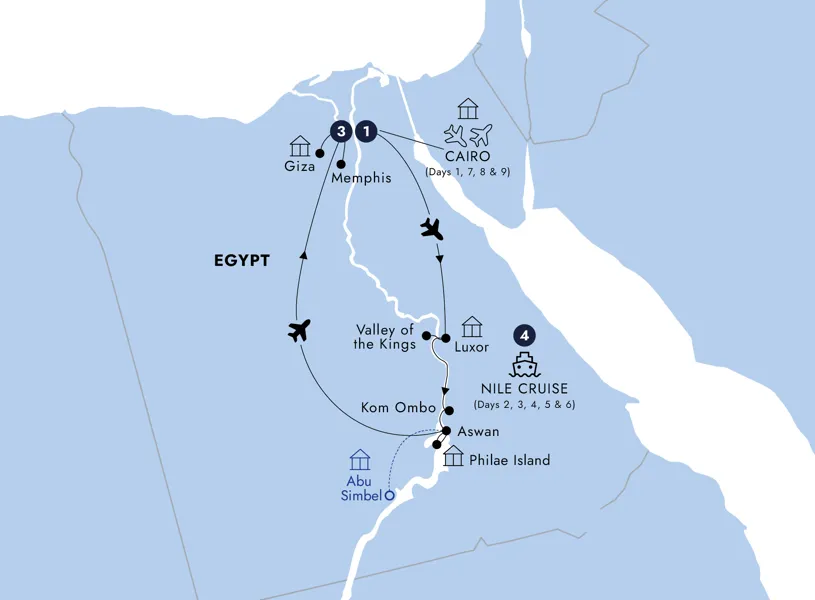Step back in time to stand in awe of the pyramids, the Great Sphinx, or Tutankhamun's treasures. Egypt is an absolutely incredible place to visit.
Top Reasons to Visit Egypt This Fall or Winter
& What Makes Egypt a Top Bucket-List Destination

Egypt is a Top Travel Destination
Quick History of Egypt
Egypt's ancient history is one of the most compelling reasons to visit. It began with the founding of the Old Kingdom around 3100 BC and lasted for 3000 years until Alexander the Great conquered the country in 332 BC, ending the rule of the pharaohs. This extensive history has left behind a wealth of monuments, temples, and artifacts that offer a glimpse into one of the world’s most fascinating ancient civilizations. From the Great Pyramids of Giza to the temples of Luxor and the treasures found in the Valley of the Kings, Egypt's historical sites are unparalleled.
Why Egypt Has Been a Top Travel Bucket-List Destination for Centuries
Egypt is a top bucket-list destination due to its unparalleled historical and cultural heritage. Iconic sites include the Great Pyramids of Giza, the Sphinx, the temples of Luxor and Karnak, the Valley of the Kings, and Abu Simbel. Travelers have been visiting Egypt for centuries, drawn by its historic allure and the timeless beauty of its ancient monuments. The country's unique blend of history, culture, and natural beauty continues to captivate visitors from around the world.

Visit Egypt in Fall or Winter for Ideal Weather Conditions
Pleasant Temperatures for Sightseeing
The weather in Egypt between late September and early February is perfect for exploring historical sites. During these months, the temperatures are much cooler compared to summer, making it more comfortable to walk around and enjoy outdoor sightseeing activities. Daytime temperatures are generally mild and pleasant, while the evenings are cooler, providing a refreshing break after a day of sightseeing. This makes it an ideal time for visitors to experience Egypt's rich cultural and historical heritage.
Fewer Crowds at Major Attractions
Exploring historical sites like Luxor and Karnak Temple during these months comes with the advantage of a more relaxed touring experience. The lack of large crowds allows for a more immersive experience, giving you the chance to fully appreciate the details and history of these ancient sites. You can take your time exploring and learning about the significance of each site without feeling rushed, making for a more enriching and enjoyable visit.
Enjoy the Pyramids in Peace
Visiting the Pyramids of Giza during the autumn and winter months means fewer tourists, allowing you to enjoy these iconic sites without the usual hustle and bustle. This peaceful atmosphere enhances the overall experience, making it more memorable. The reduced number of visitors also provides better opportunities for photography, allowing you to capture stunning images without summer’s crowds. Additionally, it offers a more personal and intimate experience as you explore the grandeur of the pyramids and the Sphinx.

Fall & Winter in Egypt Are Optimal for Outdoor Activities
Perfect Conditions for Nile River Cruises
The weather between September and January is ideal for Nile River cruises. The mild temperatures make for a comfortable and enjoyable journey along the river, allowing you to take in the scenic views and explore the various stops along the way. The pleasant temperatures and clear skies provide perfect conditions for enjoying the outdoor decks and taking in the breathtaking landscapes that line the Nile. Whether you’re visiting temples and tombs or just relaxing on the boat, the cooler weather definitely enhances the overall experience.

Best Places & Historic Sites to Visit in Egypt in Autumn and Winter
The Great Pyramids and the Sphinx at Giza
No visit to Egypt is complete without seeing the Great Pyramids and the Sphinx at Giza. These iconic landmarks are not only architectural marvels but also symbols of Egypt’s rich and fascinating history. Fewer crowds during the autumn and winter months mean you can enjoy these historical sites without the usual hustle and bustle, allowing for a more intimate and leisurely experience. Taking your time makes it easier to appreciate the grandeur and historical significance of these ancient wonders. Plus, the cooler weather makes exploring the vast Giza Plateau much more comfortable, enhancing the overall experience.

The Ramses II Statue & Alabaster Sphinx in Memphis
The top sites of Memphis, including the Ramses II statue and the Alabaster Sphinx, offer a glimpse into the grandeur of ancient Egyptian civilization and the artistry of its craftsmen. The imposing statue of Ramses II, one of Egypt's most powerful and celebrated pharaohs, stands as a testament to his enduring legacy. Crafted from a single block of granite, the statue showcases the exceptional skill and precision of ancient Egyptian sculptors. Nearby, the Alabaster Sphinx, with its serene expression and impressive size, complements the site, providing visitors with a deeper appreciation of the artistic and architectural achievements of the time.
The Step Pyramid of Djoser in Saqqara
The Step Pyramid of Djoser in Saqqara is the oldest pyramid in Egypt and a significant archaeological site. Designed by the architect Imhotep, this pyramid marks a pivotal moment in ancient Egyptian architecture, representing the transition from traditional mastaba tombs to the grand stone pyramids that would follow. The pyramid’s unique stepped design, consisting of six mastaba-like layers stacked upon each other, reflects the innovative spirit of the era. As you explore the site, you can see remnants of the surrounding complex, including courtyards, temples, and shrines, which together offer a comprehensive glimpse into the early stages of pyramid construction and the ceremonial practices associated with it.
Visiting during the cooler months allows you to explore this pioneering structure in comfort without the intense heat that can make summer visits challenging. The milder temperatures provide a more pleasant experience as you wander through the expansive archaeological site, enabling you to take your time and fully absorb the historical significance of the Step Pyramid. The cooler weather also makes it easier to appreciate the intricate details of the pyramid and the surrounding structures, as well as the vast desert landscape that frames this remarkable monument. Whether you are an avid history enthusiast or a casual traveler, the Step Pyramid of Djoser and the surrounding sites of Memphis offer a fascinating journey into the heart of ancient Egypt’s architectural and cultural heritage.

Luxor and Its Temples
Luxor is home to some of Egypt's most famous temples, including Karnak, Queen Hatshepsut's Temple, and Luxor Temple. We think it's much better to visit in autumn and winter months due to the cooler weather. The milder temperatures make walking around these expansive sites more enjoyable, allowing you to fully appreciate their architectural splendor and historical significance. This quieter period provides a more serene atmosphere for exploring and photographing these ancient wonders, making your visit to Luxor truly memorable.
Museum of Egyptian Antiquities
The Museum of Egyptian Antiquities, established in 1900, boasts the most impressive collection of Egyptian antiquities and pharaonic treasures in the world. Located in the heart of Cairo, the museum displays an astonishing number of objects, ranging from mummies and sarcophagi to jewelry, pottery, and artifacts from ancient tombs. With over 120,000 items on display, the museum provides an unparalleled glimpse into Egypt’s rich history, spanning from the Old Kingdom to the Greco-Roman period.
Visiting the Museum of Egyptian Antiquities during the fall and winter months offers several advantages. The cooler weather makes exploring the museum more comfortable as Cairo’s summer heat can sometimes be overwhelming. Additionally, these months tend to be less crowded, allowing for a more relaxed and intimate experience as you navigate the galleries.
Alexandria’s Historical Sites
The city of Alexandria offers a unique blend of Egyptian and Greco-Roman history, making it an excellent destination in autumn. The city’s rich cultural heritage is reflected in its historical sites, which span different eras and civilizations. The cooler weather makes it ideal for exploring the ancient library site and the catacombs. These sites are not only significant historical landmarks but also provide fascinating insights into Alexandria's diverse past.

The Temple of Kom-Ombo
The Temple of Kom-Ombo is unique for being dedicated to two gods: Sobek, the crocodile god associated with fertility and the military, and Horus, the falcon-headed god of the sky and kingship. This dual dedication is reflected in the temple's symmetrical design, with duplicate courts, halls, and sanctuaries, each side mirroring the other.
One side of the temple is dedicated to Sobek, who was believed to control the waters of the Nile and protect the people from the dangers lurking within it. The other side is dedicated to Horus, a deity associated with protection, righteousness, and power. The intricate carvings and reliefs throughout the temple depict scenes honoring both gods, showcasing their significance in ancient Egyptian religion and mythology.
Visitors can explore the well-preserved reliefs and inscriptions that adorn the walls, which provide fascinating insights into the rituals and beliefs of the time. One of the most notable features of the temple is the "Nilometer," an ancient device used to measure the Nile's water level and predict the annual flooding, which was crucial for agriculture.
The temple's setting on the east bank of the Nile River adds to its allure. The panoramic views of the river and the surrounding landscape are especially stunning at sunset. Additionally, the nearby Crocodile Museum, which houses mummified crocodiles and artifacts related to the worship of Sobek, complements the temple visit, offering a deeper understanding of the local culture and religious practices.
Overall, the Temple of Kom-Ombo is not only architecturally impressive but also rich in historical and cultural significance, making it a must-visit site for anyone traveling to Egypt.
Temple of Isis
The Temple of Isis on the island of Philae is another must-see location in Egypt, known for its beautiful location and historical significance. The temple was painstakingly relocated to Agilkia Island to save it from the rising waters of Lake Nasser, a testament to its importance.
The High Dam and the Unfinished Obelisk in Aswan
The Aswan High Dam is a marvel of modern engineering and offers impressive views. The dam’s construction has had a significant impact on Egypt’s economy and landscape, creating Lake Nasser, one of the largest artificial lakes in the world. The Unfinished Obelisk provides insight into ancient stone-working techniques. Had it been completed, it would have been the largest obelisk ever erected, giving visitors a glimpse into the ambitious projects of ancient Egyptian rulers.

Cultural Activities to Enjoy in Egypt Between September and January
Sail in a Felucca Across the Nile
A traditional felucca sailboat ride on the Nile River is a serene activity that offers a unique perspective of Egypt’s landscapes and historical sites during the fall and winter months. These ancient sailboats, with their simple design and large canvas sails, have been used for centuries to navigate the Nile's gentle currents. As you glide along the river, the tranquility of the experience allows you to fully immerse yourself in the surrounding beauty. The gentle swaying of the felucca, coupled with the soft lapping of the water against the hull, creates a peaceful ambiance that is perfect for unwinding and taking in the natural beauty of the Nile. The cooler temperatures during these months make the journey especially pleasant, providing a comfortable atmosphere for relaxing on deck and enjoying the scenic views.
From the deck of a felucca, you can witness the ever-changing panorama of Egypt's landscapes, from lush, palm-fringed riverbanks to arid desert vistas. This leisurely pace allows for uninterrupted views of iconic landmarks such as ancient temples, bustling riverside villages, and verdant agricultural fields. Additionally, a felucca ride offers a closer connection to the local way of life, as you observe fishermen casting their nets and farmers tending to their crops along the river's edge. This intimate encounter with Egypt's timeless scenery and culture provides a memorable and enriching addition to any visit to the region.
Cairo’s Citadel and Mosques
Top sites in Cairo include the Citadel, Alabaster Mosque, and Sultan Hassan Mosque, offering a glimpse into the rich heritage of Islamic architecture. The Citadel of Cairo, a UNESCO World Heritage site, stands as a formidable fortress that has dominated the city’s skyline since its construction in the 12th century by Salah al-Din (Saladin). Originally built to protect the city from Crusader attacks, the Citadel offers stunning panoramic views of Cairo and houses several museums and mosques within its walls. The complex is a testament to Cairo’s historical and strategic importance, providing visitors with a profound sense of the city’s layered past.
Within the Citadel, the Alabaster Mosque, also known as the Mosque of Muhammad Ali, is a must-see landmark. Constructed in the 19th century, this magnificent mosque is renowned for its stunning architecture, featuring a central dome flanked by two towering minarets and a grand interior adorned with alabaster and intricate designs. The mosque’s design is heavily influenced by Ottoman architecture, resembling the famous Blue Mosque in Istanbul. Inside, the vast prayer hall is illuminated by elegant chandeliers, and the walls are decorated with beautiful arabesque patterns, creating a serene and awe-inspiring atmosphere. The Alabaster Mosque is not only a place of worship but also a symbol of Egypt’s cultural and religious history.
Another architectural gem in Cairo is the Sultan Hassan Mosque, an outstanding example of Mamluk architecture from the 14th century. This mosque-madrasa complex, located near the Citadel, is known for its massive size and exquisite design. The mosque’s monumental entrance, towering minarets, and large central courtyard reflect the grandeur and sophistication of Islamic art and architecture. The interior of the Sultan Hassan Mosque is equally impressive, with its soaring ceilings, elaborate mihrab, and finely detailed stonework. The mosque was built to serve both as a place of worship and an educational institution, housing students who studied various Islamic sciences. Its historical and architectural significance makes it a key highlight for visitors exploring Cairo’s rich Islamic heritage.
These iconic sites not only showcase the architectural prowess of different periods in Islamic history but also offer a deeper understanding of Cairo’s cultural and religious evolution. Visiting the Citadel, Alabaster Mosque, and Sultan Hassan Mosque provides an immersive experience, allowing travelers to appreciate the beauty and intricacy of Islamic architecture while gaining insight into the city’s vibrant past.
Traditional Egyptian Markets
October, November, or December is a great time to visit traditional markets and bazaars in Egypt. The markets are less crowded, and the cooler temperatures make for a more enjoyable shopping experience. Exploring local markets, such as the famous Khan El Khalili bazaar in Cairo, provides an immersive experience where you can sample a diverse array of traditional snacks and sweets.

Ideal Time for Local and Regional Cuisine in Egypt
Visiting Egypt between September and January offers an excellent opportunity to enjoy the country’s local and regional cuisine. The cooler weather makes outdoor dining more pleasant, allowing you to explore bustling markets and street food stalls without the discomfort of the summer heat. The fall and winter months also coincide with the harvest season for many fruits and vegetables, ensuring that the produce is fresh and abundant. This is the perfect time to savor seasonal specialties such as pomegranates, dates, and citrus fruits, which are often incorporated into both savory and sweet dishes.
Local and Regional Dishes to Try in Egypt
In Cairo, you can sample traditional dishes like koshari, a hearty mix of rice, pasta, lentils, and chickpeas topped with a spicy tomato sauce and fried onions. Another must-try is ful medames, a savory fava bean stew typically served with fresh bread and vegetables.
Coastal regions like Alexandria offer a rich variety of seafood dishes, including grilled fish, shrimp, and calamari, all freshly caught and seasoned with local herbs and spices. In Upper Egypt, dishes like molokhia, a green leafy vegetable soup, are popular. Meanwhile, in the Nile Delta region, you can try dishes like feteer meshaltet, a layered pastry often filled with cheese or honey.
Don't miss out on trying one of our favorite Egyptian meals: Shakshuka, a delicious dish of poached eggs in a rich tomato and pepper sauce, often enjoyed for breakfast or brunch.
How to Make Egyptian Shakshuka
These culinary experiences not only satisfy your taste buds but also provide a deeper understanding of Egypt’s rich cultural heritage.

Why You Should Visit Egypt in the Fall or Winter
Visiting Egypt in the fall or winter offers the perfect combination of ideal weather, fewer crowds, and unique cultural experiences. From exploring the Great Pyramids of Giza and sailing on the Nile to enjoying traditional markets and local cuisine, these months provide a more comfortable and enriching travel experience. A guided tour ensures you make the most of your trip, with expert insights and seamless logistics, allowing you to fully immerse yourself in the wonders of Egypt.
Frequently Asked Questions About Traveling to Egypt in the Fall & Winter
The best time to tour Egypt is between October and January, when the weather is cooler and more comfortable for exploring Egypt's ancient sites.
Top places to visit in Egypt include the Great Pyramids of Giza, the temples of Luxor and Karnak, the Valley of the Kings, Abu Simbel, and the Egyptian Museum in Cairo.
The currency in Egypt is the Egyptian pound (EGP).
Egyptian cuisine is rich and diverse, with popular dishes like shakshuka, koshari, ful medames, molokhia, and a variety of seafood, especially in coastal regions.
Credit cards are widely accepted in major cities and tourist areas. However, it’s advisable to carry some cash for smaller establishments and markets. Check out this article on exchange rates and using credit cards abroad.
Don't forget essentials like travel adapters, a reusable water bottle, and any personal medications. If you plan to visit religious sites, modest clothing is respectful and covering women's shoulders and knees may be required.
Egypt uses a voltage of 220V with a frequency of 50Hz.
English is widely spoken in tourist areas, hotels, and major cities.
The weather in Egypt between October and December is mild and pleasant, with cooler temperatures ideal for sightseeing.
We always recommend checking with your healthcare provider for any necessary vaccinations before traveling to Egypt.
Yes, a visa is required to visit Egypt. Ensure your passport is valid for at least six months beyond your planned stay.
Egypt is generally safe for tourists. However, like any other country, it is important to stay aware of your surroundings, especially in crowded tourist areas, and follow standard travel safety practices.
We recommend spending at least 7-10 days in Egypt to explore its major attractions and enjoy its diverse regions.
We recommend you plan your Egypt trip between 3-10 months before you want to travel. Airlines don’t publish fares much further out than 10-11 months. You should look to book your vacation once you can lock in your flights. Luckily, we take care of all of that for you. If travelers want to go for a special anniversary or event, they’ll book years in advance so they know they are set and can let us handle it from there. It’s essential to ensure your passport is valid for at least six months after you’re planning to return to the States and that you have any visas you’ll need to travel. Planning earlier allows you plenty of time to renew your passport or apply for a visa if required. Travel rules are changing daily. Check and make sure you’re ready to go! Visit our travel requirements and restrictions page to learn more.






















